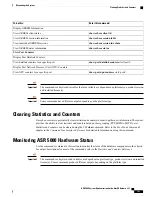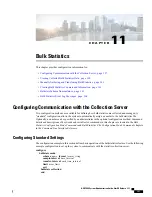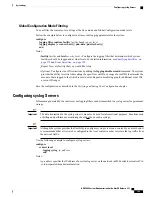
•
Event
: Event logging can be used to determine system status and capture important information pertaining
to protocols and tasks in use by the system. This is a global function that will be applied to all contexts,
sessions, and processes.
•
Active
: Active logs are operator configurable on a CLI instance-by-CLI instance basis. Active logs
configured by an administrative user in one CLI instance cannot be viewed by an administrative user in
a different CLI instance. Each active log can be configured with filter and display properties that are
independent of those configured globally for the system. Active logs are displayed in real time as events
are generated.
•
Trace
: Trace logging can be used to quickly isolate issues that may arise for a particular connected
subscriber session. Traces can be taken for a specific call identification (callid) number, IP address,
mobile station identification (MSID) number, or username.
•
Monitor
: Monitor logging records all activity associated with a particular session. This functionality is
available in order to comply with law enforcement agency requirements for monitoring capabilities of
particular subscribers. Monitors can be performed based on a subscriber's MSID or username.
•
Crash
: Crash logging stores useful information pertaining to system software crashes. This information
is useful in determining the cause of the crash.
Configuring Event Logging Parameters
The system can be configured to generate logs based on user-defined filters. The filters specify the facilities
(system tasks or protocols) that the system is to monitor and severity levels at which to trigger the generation
of the event entries.
Event logs are stored in system memory and can be viewed via the CLI. There are two memory buffers that
store event logging information. The first buffer stores the active log information. The second buffer stores
inactive logging information. The inactive buffer is used as a temporary repository to allow you to view logs
without having data be overwritten. Logs are copied to the inactive buffer only through manual intervention.
Each buffer can store up to 50,000 events. Once these buffers reach their capacity, the oldest information is
removed to make room for the newest.
To prevent the loss of log data, the system can be configured to transmit logs to a syslog server over a network
interface.
For releases after 15.0 MR4,
accounting (CLI event logging) will not be generated for Lawful
Intercept users (priv-level 15 and 13).
Important
Configuring Event Log Filters
You can filter the contents of event logs at the Exec mode and Global Configuration mode levels. For additional
information, see the
Command Line Interface Reference
.
ASR 5000 System Administration Guide, StarOS Release 21.1
166
System Logs
Configuring Event Logging Parameters
Summary of Contents for ASR 5000
Page 26: ...ASR 5000 System Administration Guide StarOS Release 21 1 xxvi Contents ...
Page 316: ...ASR 5000 System Administration Guide StarOS Release 21 1 288 VLANs VLAN Related CLI Commands ...
Page 400: ...ASR 5000 System Administration Guide StarOS Release 21 1 372 Engineering Rules ECMP Groups ...










































